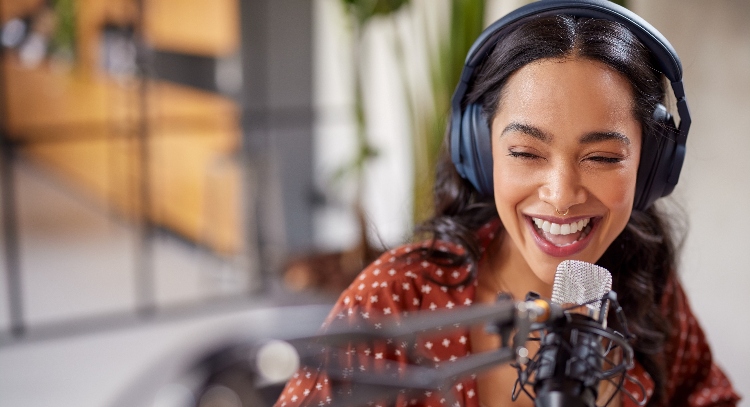As digital content reigns supreme, video stands out as a crown jewel. Video content can’t be the same for every social media platform since they have different audiences. It’s important to tailor video content for each platform to engage your audience effectively. And when it comes to resonance, nothing amplifies a video’s impact quite like the perfect voice over.
Sign Up for Free Today
Find the perfect voice for your job today, or sign up as a talent to start booking voice over work on Voices.
In this article
- Understanding Different Platforms
- Tailoring Video Content for Each Platform
- The Impact of Voice Overs
- Video Content Success Stories
- Nike’s “Just Do It” Campaigns
- Duolingo’s TikTok Strategy
- TED Talks on YouTube and LinkedIn
- Headspace’s Guided Meditation Videos
- Best Practices and Tips
- Know Your Audience
- Be Platform-Specific
- Choose the Right Voice
- Final Thoughts
Understanding Different Platforms
The digital world is a mosaic of platforms, each with its distinct flavor. YouTube, the grandfather of video content, is a haven for longer, more detailed content. Instagram and TikTok are the playgrounds of the quick and trendy, where short, captivating videos thrive. Facebook videos must be both informative and entertaining. LinkedIn requires a professional tone as it focuses on industry insights and thought leadership.
Different platforms cater to different demographics. TikTok, for instance, is a hub for Gen Z, while LinkedIn hosts a professional crowd. To make video content work, we need to tailor it for the specific audience of each platform.
Tailoring Video Content for Each Platform
Crafting platform-specific video content involves more than cutting down lengths or changing formats. For YouTube, in-depth tutorials or storytelling videos with detailed narration work wonders. Instagram and TikTok videos need catchy, concise voice overs that grab attention within seconds. Facebook videos can be conversational, perhaps with a hint of humor. LinkedIn voice overs should sound authoritative and address industry trends or business insights.
Understanding the preferred video style of each platform is equally important. For instance, TikTok favors creative, engaging content, while LinkedIn values educational and professional material.
The Impact of Voice Overs
We cannot overstate the power of voice in video content. A compelling voice over can transform a simple video into an engaging story. An engaging voice over can make complex topics more digestible on platforms like YouTube. For quick-paced platforms like TikTok, a dynamic, energetic voice can enhance the excitement of the video. A clear, confident voice on professional platforms like LinkedIn enhances credibility.
Video Content Success Stories
Brands and organizations use platform-specific videos and voice overs to engage audiences and meet marketing goals. Here are some real-life examples.
Nike’s “Just Do It” Campaigns
Nike’s approach to video content across platforms demonstrates the art of tailoring. Their “Just Do It” campaigns showcased inspiring stories of perseverance and triumph with powerful voice overs. They adjusted their content for Instagram and TikTok, using shorter, energetic videos with famous athletes’ motivational messages. This appealed to a younger, active audience.
Duolingo’s TikTok Strategy
Duolingo’s success on TikTok is a perfect example of platform-specific video content done right. They capitalized on TikTok’s trends and humor with short, engaging videos featuring their mascot. They showcased their language learning services through humorous voice overs in different languages. This built a relatable brand persona that resonated with the platform’s younger audience.
TED Talks on YouTube and LinkedIn
TED Talks offer a great example of adapting digital content for different platforms. Their longer, detailed talks on YouTube have clear, engaging voice overs. This makes complex topics interesting and accessible to a wide audience. On LinkedIn, they share shorter clips from the same talks that focus on professional development and innovation. The clips have a voice over style that appeals to the platform’s business-oriented audience.
Headspace’s Guided Meditation Videos
Headspace, a popular meditation app, effectively uses platform-specific videos to promote mental wellness. On YouTube, they have longer meditation sessions with calming voices that help you relax and be mindful. On Instagram, they make short, visually pleasing clips with calm voices that teach quick relaxation techniques. This fits the platform’s preference for concise content.
Best Practices and Tips
When creating videos for different platforms, consider the following:
Know Your Audience
Tailor the content and voice over to match the platform’s predominant demographic.
Be Platform-Specific
Adapt the video’s length, style and tone to suit each platform.
Choose the Right Voice
The voice over artist should resonate with the audience and reflect the video’s mood.
Final Thoughts
Understanding your audience and adapting your content is the key to tailoring your videos for each social media platform.
By choosing the right voice to tell your story, you can ensure that your message not only reaches your audience but also resonates with them. When it comes to digital content, being platform perfect is not only an advantage — it’s a necessity.

Leave a Reply